Greetings, chronic argonauts! We’ll be stepping into the time machine in just a moment, and once we do we’re mostly going to let the music do the talking. But we wanted to take a moment to think some deep thoughts about history and nostalgia. It started when Friend of Popdose and All-Around Internet Swell Guy Andrew Weiss sent us a link to the archives of SPIN — their review of the Like, Omigod! box set, written by Jesse Berrett upon its original release in 2002. It’s worth reading in full, but a couple of lines jump out…
… ”Nothing about the 80s was naive.” Even pop’s exuberant synth-bleeps throbbed with dread. That may explain why the renewed vogue for those sounds coincided with an unwelcome 80s revival in the culture at large (Enron, terrorism, the threat of nuclear war). But of the 142 songs included on Like Omigod!, only one. Nena’s ”99 Luftballons,” has much to say about apocalypse. As a result, Like Omigod! is a sunny retro fetish object itself — totally 90s, if you will.
…. Take this as a That 80s Show soundtrack, if you like. But this is a safer, dorkier 80s than even the decade’s most mainstream pop deserves…
Written history is always as much about the present as about the past. Edward Gibbon’s Decline and Fall of the Roman Empire, written in the 1770s, is still read today, not only for its insights into the Caesars, but for what it tells us about the mores and attitudes of late 18th Century England. With the American Revolution raging across the ocean, Gibbon’s thoughts were clearly of the coming decline and fall of the British Empire.
Similarly, Jesse Berret, with a mind on the problems of 2002, criticizes a box set of 80s music for having an outlook that’s stuck in the 90s. (It gets a little dizzying.) We started wondering if we, writing in 2013 with the benefit of an additional decade of hindsight, had any better handle on the Eighties and their meaning than the compilers at Rhino did in 2002…
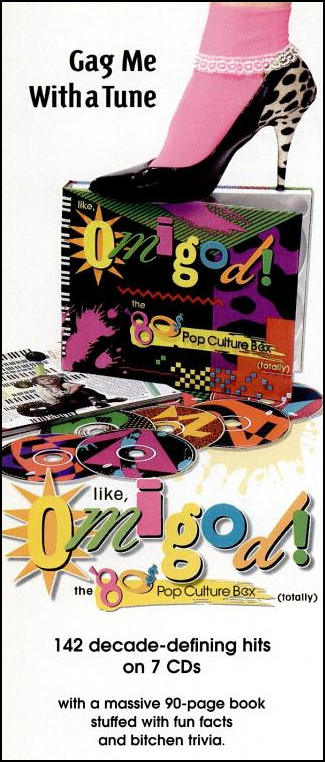 Jack Feerick — What’s interesting to me is how little the Eighties canon has changed in the last ten years. Simply by being first past the post, Like Omigod! basically laid down the playlists for the ”Big 80s” radio format on satellite and terrestrial radio. And by emphasizing the bright, perky, neon-and-pastel dorkiness, it’s coloring how we remember the decade — although our personal experiences of the era might have been very different indeed.
Jack Feerick — What’s interesting to me is how little the Eighties canon has changed in the last ten years. Simply by being first past the post, Like Omigod! basically laid down the playlists for the ”Big 80s” radio format on satellite and terrestrial radio. And by emphasizing the bright, perky, neon-and-pastel dorkiness, it’s coloring how we remember the decade — although our personal experiences of the era might have been very different indeed.
Annie Zaleski — Like commercial radio, these sets are creating a revisionist history of the decade. Look at classic alternative radio. A lot of the one-hits or deep album cuts have been excised from playlists in favor of the overplayed ones. I think this set embodies that phenomenon, in fact.
Feerick — Another complaint that I’ve heard about this set is that there’s very little hip-hop, and very little hair metal — two genres that, good or bad, were huge in the 80s — and entirely too many novelty songs.
Dave Lifton — I don’t mind the novelty songs. They were a part of the decade — every damn Morning Zoo played them — so why not include them? What I do mind, however, is the low percentage of black artists. It literally whitewashes the decade.
Feerick — Mm. We talked about this a little bit last week, too, and I’ll just repeat what I said then: there were some huge missed opportunities.
Jon Cummings — It seems to me that Like, Omigod! plays out pretty much the same way AM Gold played out (and everyone who contributed to that series participated in several discussions of what’s-here-vs.-what’s-missing). It’s poppish rather than rockish, soulish or rappish, partly because it had to put its focus somewhere (as opposed to other comp series that might be more rockish), and partly (probably) because the older white people who buy expensive box sets want to hear Gary Numan more than they want to hear Grandmaster Flash.
Ted Asregadoo — It’s a bit like David Lynch approached Blue Velvet: part of the movie has a sunny, safe, sheen to it (and that would be the tracks that are in Like, Omigod!), but underneath that glow, there’s the underground — where unsettling things happen. Those tracks would be early hip-hop and alternative rock that addressed the flip side to the Reagan Revolution. You know, A and B sides.
Feerick — The ”classic alternative” format that Annie talks about is useful, I think, as just that sort of counter-narrative (for one thing, it’s got all the apocalyptic dread that was missing from Like, Omigod!) . And one positive development over the last decade is that you’ve got several alternate narratives to choose from. Besides the Big 80s and Classic Alternative, you’ve seen the rise of an Old School Hip-Hop radio format; hair metal not only has a dedicated presence on satellite, but has become a force again on terrestrial as many Classic Rock stations retool their playlists to shift everything up a decade. (It’s ”not your father’s classic rock,” so instead of 60s and 70s, they play 70s and 80s — which means G n’ R, Quiet Riot, Poison, Twisted Sister, and the like.)
Dan Wiencek — I’m hesitant to ascribe a great deal of significance to Like, Omigod!‘s track listing, to be honest. It’s a mix of what Rhino could afford to put on it (thus no Madge, no Michael Jackson, no Prince) and what they thought us former ’80s kids would pony up and pay for. The last thing it should be looked at is as a serious attempt to define the 1980s through its music.
I remember the long back-and-forth that ensued when we were choosing the set for this project. It was pretty apparent that aesthetically, Like, Omigod! is kind of a dud. But we wanted something that offered breadth, and not withstanding the shortcomings noted above, this was the best option out there.
Feerick — It’s a fascinating dud, though — far more interesting, for my money, than something handpicked from the cream of what’s available and collated with impeccable care and taste. It’s got some of the haphazard WTF-ness that only comes from the whims of the marketplace.
In other words: It’s not a mixtape, it’s the radio in the corner of the coffeeshop.
Wiencek — Oh, I agree. It’s much closer to what I was actually hearing back then (good and bad) than something like Just Can’t Get Enough.
Dw. Dunphy — Something else that jumps out is that this was initially a CD box set, and in a sense the very medium used to catalog a former decade is in itself considered obsolete (by many).
Feerick — …2002, of course, being right at the turning point of the MP3 era — the year after Napster shut down, the year before the iTunes Store opened. Sorry, carry on.
Dunphy — As for the actual list of songs, I think that the things we were trying to escape through music in that era were things we still were trying to escape from, so the most regressive aspect of the box set is that we hadn’t changed all that much.
Rock likes to be considered as an accurate tentpole of its times and occasionally is. Mostly it is cloud cover to mask unpleasant realities. Modern pop is the same. It is still love and hate and retreating to the refuge, be it the honky-tonk saloon, Da Club, or a thousand other variations of decompression chamber where we choose what gets in and what cannot.
Feerick — Only in this case, we’ve got the folks at Rhino playing bouncer for us. The evening is wearing on — we’re wrapping up Disc Five of this seven-disc set — so let’s see who has slipped in past the velvet rope this time…
#16 Ray Parker Jr, ”Ghostbusters” (1984)
A US chart-topper for three weeks; UK #2; nominated for an Academy Award.
Feerick — Even Ray Parker admits that he was biting Huey Lewis’s ”I Want a New Drug” pretty hard on this one, and it’s obvious he knew how monotonous it was getting; I’d forgotten how many different instrumental breaks there are in this. But they have nowhere to go but back to that bassline, and the song never really develops.
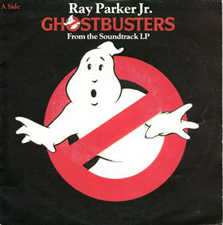 I’m surprised, on this close listening, by how much of his bedroom voice ray brings to this one. His performance is one long, winking seduction, even with the oboxious backing vocals cock-blocking him at every turn.
I’m surprised, on this close listening, by how much of his bedroom voice ray brings to this one. His performance is one long, winking seduction, even with the oboxious backing vocals cock-blocking him at every turn.
And the video! Terri Garr! Judge Reinhold! George Wendt! Were any of these people actually in the movie? Or was this specifically shot as a recruiting video for the Future Show-Biz Has-Beens of America?
Dunphy — I can’t enjoy this as a song, and barely could when it first came out. There’s nothing wrong with it. It’s kind of funky, but it is in every way, a theme song and there is something extremely dorky and off-putting about driving around with people shouting “Ghostbusters” out of your speakers.
Cummings — Yeah, yeah, Huey Lewis, blah blah blah. In 1984 they called this plagiarism; in 2013 we’ve spent 20 years universally calling it sampling. Besides, it was a great riff to pinch, Ray got a #1 hit, Huey eventually got his cut of the proceeds, and everybody’s happy. This week we’ve got two prime examples of the soundtrack smash — this one, a simplistic and rhythm-heavy track that looked to do little more than hammer the movie title into your head (and succeeded brilliantly); the next one, a slightly less reductive (and more verbose) celebration of its film’s key themes that fit nicely into the film’s climax and cemented it in the public consciousness.
Lifton — I guess I can see now how the lyrics kind of match the silliness of the movie, but at the time I thought it was weak. I still don’t like it, but at least now I hear it in a different context.
#17 Kenny Loggins, ”Footloose” (1984)
The first of two #1 hits from the soundtrack to the film.
Feerick — There’s a credit card commercial on the air now that has ruined whatever modest charms ”Footloose” might have ever held for me. I’ll only say that between this and ol’ Johnny Cougar’s ”Authority Song,” 84 was a good year for the Duane Eddy-style twang guitar riffs.
Dunphy — Like “Ghostbusters,” “Footloose” is more dependent on the movie than a song should be in order to be enjoyed separately…but at least the title isn’t blurted out every couple seconds. I can listen to this without that weird creeping feeling of judgment over my musical choices, but it doesn’t measure up to “I’m Alright” from Caddyshack.
Cummings — Is this the perfect film title song for the ’80s? Arguments could be made that this smash simultaneously made Kenny Loggins’ career (it no doubt bought him a few houses, some very nice vacations and a bit of cosmetic work around the temples) and rendered him a one-trick pony, from whom fans wanted to hear nothing but soundtrack catnip. In any case, resistance was futile during the spring of ’84 — and one ALSO could argue that a little film about clashing morals and mediocre dancing, featuring a barely known lead actor and a lead actress who disappeared soon afterward, never could have gotten off the ground without a trump card like Kenny’s.
Lifton — Yeah, it was effective for the movie — and everything Jon says is true. But, guitar lick or not, it’s still a weak song.
#18 Twisted Sister, ”We’re Not Gonna Take It” (1984)
The band’s only Top 40 single, reaching #21.
Lifton — This, and “Cum On Feel The Noize” were about as close as I got to metal back then. It was rebellious for people who had no real reason to rebel. I still love how awful the guitar solo is, like the guy just figured out how to use the whammy bar during the recording of it.
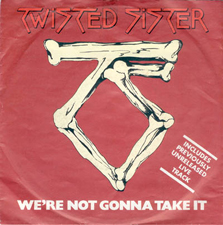 Cummings — Helllooooooo, hair metal! You know, during 1984 I never gave a moment’s thought to the fact that Neidermeyer and Chip were spending the summer showing back-to-back on MTV. But it sure was nice to see Dougie again.
Cummings — Helllooooooo, hair metal! You know, during 1984 I never gave a moment’s thought to the fact that Neidermeyer and Chip were spending the summer showing back-to-back on MTV. But it sure was nice to see Dougie again.
Feerick — I never realized, until this close listening, that Dee is actually quoting lines from Animal House (”A pledge pin? On your uniform?“) at the fade-out. The presence of Niedermeyer in the video makes a bit more sense, now.
Without the distraction of the video or the visuals of the band themselves, it’s easier to hear what Twisted Sister is up to here. There are obvious elements of glam — mostly in the drums and the gang vocals; the guitars are pretty underwhelming throughout — but there’s a little bit of theater-kid showbiz in the ascending bit leading into the chorus. That Dee Snider would end up singing show tunes seems obvious in retrospect.
Dunphy — About a year or so ago there was a commercial where a motel occupant was ticked off that his room was so bad, so he stormed the parking lot with the rest of the motel patrons singing “We’re Not Gonna Take It” — only “storming” is too kind. It was more like stupidly choreographed stalking that portrays anger and fails to convey anything amounting to a real emotion. Which may be appropriate because even though I enjoyed this song as a teen, I’ve come to recognize there was a whole lot of fake anger in me and my classmates. We probably thought we were tough as shark balls too, but really, we looked more like this…
#19 Scorpions, ”Rock You Like a Hurricane” (1984)
Hit #25 US; #78 UK, though it was a Top Twenty hit in France.
Dunphy — And so we’ve finally rot’chu to this. Scorpions were always kinda pigs, and they didn’t care. They knew that the more famous they got, the more attractive they became to people. It didn’t matter about how hard or not hard they rot’ched because, if that was the real criteria for their success, it wouldn’t explain why the previous Blackout rot’ched so much better and more authentically than the Love At First Sting record. Of course, they’re still composing odes to size queens and groupies, but they were so caught up in the thrill of it all I doubt they were at all concerned they were becoming their own punchlines.
Feerick — ARE YOU READY FOR ME BAY-BE-E-E-E-EE?!?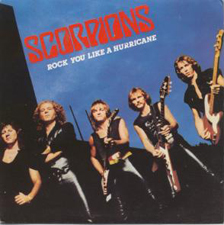
I used to be in a band that did this — and ”99 Luftballons,” too, now I think of it, though we weren’t particularly Deutschophiles —and our PA blew up on us one time going into the last chorus. (It was just a bum fuse, though the bass player would in time embroider the story until it ended with his leg catching fire.)
Anyway, I still love ”Rock You Like a Hurricane,” unabashedly and unironically. It’s about as good as pop-metal gets, with a bludgeoning riff, a stupidly-great chorus, hot solo, and a punchy ending.
And Klaus Meine — Jesus, what a monster. A writer for the Boston Globe — I think it was Steve Morse, but I’m not sure — once described Meine in print as ”the bravado of David Lee Roth in the body of Woody Allen.” I always loved that idea — that this skinny wee man, with his bad teeth and worse hair, could be a mighty rock god just by force of will. He is an object lesson in the power of self-belief and confident presentation, and I deem him both rockin;’ and lovable. If there’s hope for him, there’s hope even for me.
Cummings — You mean, “hurruhcan”? The whole cage-match setting of the video can’t help but remind me of Sam Kinison’s video for “Wild Thing” — which inevitably leads me to think of Sut Jhally’s bullshit “documentary” Dreamworlds (a brief update of it can be seen here ), which juxtaposed Kinison’s (obviously tongue-in-cheek) video with footage of the (deadly serious) rape scene from The Accused to accuse the entire music-video industry of debasing and torturing women. I mean, not that he was necessarily wrong …
Feerick — Misogyny? Objectification of women? In pop music? Perish the thought!
Cummings — …but his moralism was even worse than Tipper Gore’s in that era, and his tone-deafness to the entirety of rock culture thoroughly disqualified him from commenting on any aspect of that culture. Not to mention the fact that Dreamworlds reduced a heretofore pretty reasonable, but highly impressionable female friend of mine to a blubbering mass of male-hatred who stopped speaking to me for days after I told her the film was crap.
Oh — the song? Whatever. “Give her inches and feed her well.” Maybe Sut had a point.
Lifton — The mark of a great pop-metal song is how much more memorable the chorus is than the verses.
#20 Sheila E., ”The Glamorous Life” (1984)
Reached #7 on the Hot 100, though it topped the Club Play charts. A #2 hit in Holland, for whatever reason.
Feerick — Man, I don’t know. At this point Prince was writing everything for everybody, but his hand is a little too visible inside the puppet’s head for me to dig this. It sounds like Sheila overdubbed her voice and percussion onto a Prince demo and put it out without even bothering to erase his guide vocal.
Michael Parr — Ding! Ding! Ding! Give the man a prize. This track was supposed to belong to Apollonia; that is until Sheila hit Prince’s radar and he handed the hit to her in exactly the state that you hear here. As with most of things of this vintage in Prince-land, he played everything save for the sax, cello, and percussion.
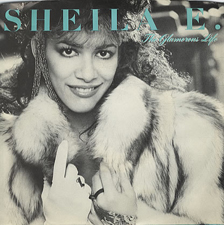 Dunphy — Yes, the Prince sausage factory (wait, that didn’t come out right) knew how to grind it out (still not right), but when he laid into a groove (this is getting pointless) he certainly knew what he was doing. So just about every act that emanated from the Paisley Park camp had the benefit of quality workmanship, but just the same hardly any of them had an identity to call their own. Prince is a powerhouse musician, no doubt, but he could never have been a Berry Gordy. He just could not get out of his own way enough to let those around him share enough of the spotlight. In my opinion, this song is the best of the week but it feels misplaced to say that it is a good Sheila E. song. And that’s unfortunate.
Dunphy — Yes, the Prince sausage factory (wait, that didn’t come out right) knew how to grind it out (still not right), but when he laid into a groove (this is getting pointless) he certainly knew what he was doing. So just about every act that emanated from the Paisley Park camp had the benefit of quality workmanship, but just the same hardly any of them had an identity to call their own. Prince is a powerhouse musician, no doubt, but he could never have been a Berry Gordy. He just could not get out of his own way enough to let those around him share enough of the spotlight. In my opinion, this song is the best of the week but it feels misplaced to say that it is a good Sheila E. song. And that’s unfortunate.
Lifton — The high point of her career, and yet it’s essentially a footnote in Prince’s. I wish she could have kept up the momentum on the pop charts. Still a great record, and I remember seeing her on the Grammys that year with those glow-in-the-dark drumsticks and thinking, “Wow, she’s really good.”
Cummings — Yeah, she could sure hit them drums in ultra-’80s style and look and sound like a female Prince … one among many, as it turned out. But wasn’t that the entire point of Sheila E’s pop career? I’m glad she’s gone on to have some success as a jazz artist, though.





Comments